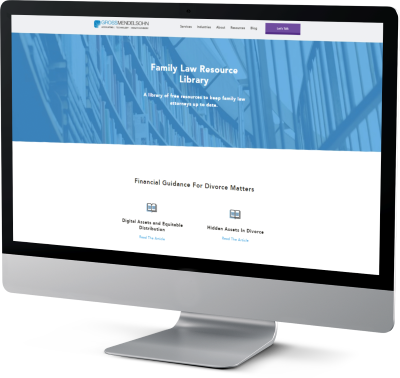As a family law attorney, you’ve likely encountered the contentious concept of “double dipping” during divorce proceedings. Double dipping occurs when the same income stream is counted twice — first as an asset to be divided during equitable distribution, and then again as income for calculating spousal support.
This issue often arises in cases involving retirement pensions and closely-held business interests. In this article, we’ll break down the double dipping debate, explore key court cases and examine how different jurisdictions handle this financial dilemma.
Background of the Double Dip Phrase
The concept of “double dip” in family law originated in cases involving retirement pensions. Some noted that including the monthly pension benefit into calculations of income for support purposes — while also including the present value of the pension as an asset to be divided — double counted the pension, unfairly penalizing the spouse who was the original plan beneficiary.
Business Interests
Over time, this conversation shifted to closely-held business interests.
Frequently, these interests are valued using an income approach, which estimates the business’s current value based on its ability to generate future cash flows. When determining income for support purposes, the income from the business is also included in the calculation of the business-owning spouse’s income. As such, some have argued that, when using an income approach, the business’s future cash flows are being counted twice.
Proponents of the double dipping argument have argued that, similar to a pension, a business’s value (when using an income approach) is based on its future benefits to the owner. However, as an article by the American Academy of Matrimonial Lawyers notes, “this is a misuse of the concept of double dipping and the principal must be confined to pension-type assets where the asset is the income, not businesses where the asset’s value and the income it produces are separate entities. Equitable distribution is a property right based on the fair market value of assets, whereas spousal support is a needs-based concept-based income.” (Morgan, 2012)
Court Cases and Interpretation
Some have tried to argue the double dipping theory in relation to closely-held business interests. In Steneken v. Steneken, a New Jersey case, a husband’s business was valued using the excess earnings method, which determines the value of a business interest by capitalizing the owners’ compensation in excess of the fair market salary for a replacement. The business earnings were also included in the calculation of income available for support purposes. The husband argued that the same income stream was being counted twice ¾ once in the valuation and again in calculating income for support purposes.
The New Jersey Supreme Court, however, disagreed. The Supreme Court stated in its decision (Steneken v. Steneken, 2005):
“Much of the controversy […] stems from the unspoken premise that because alimony and equitable distribution are interrelated, a credit on one side of the ledger must perforce require a debit on the other side; otherwise, defendant claims, the interplay between alimony and equitable distribution results in ‘double counting.’ We disagree. […] we are guided by the principle that, although clearly interrelated, the structural purposes of alimony and equitable distribution are different.”
“Equitable distributions are intended to be in addition to, and not as substitutes for, alimony awards.”
However, in Grunfeld v. Grunfeld, a New York case, the husband who argued “double dipping” was successful.
In this case, the husband was an attorney who obtained a law license during the marriage. Because his license was acquired during the marriage, per New York precedent, the license was a marital asset subject to equitable distribution. The law license was valued by discounting future excess earnings. Further, the wife was awarded support based upon the husband’s earnings, which, the husband argued, were included in the valuation of his law license.
The New York Court of Appeals and the Supreme Court of New York Court agreed, referencing the previous McSparron v. McSparron decision, “the courts must also be meticulous in guarding against duplication in the form of maintenance awards that are premised on earnings derived from professional licenses.” (Grunfeld v. Grunfeld, 1999)
Treatment In Virginia
Available case law in Virginia does not support double dipping arguments. In Hoebelheinrich v. Hoebelheinrich (43 Va. App. 543 (Va. Ct. App. 2004), the Court did not agree with the husband’s arguments that awarding his wife half of the value of his business as well as spousal support to be paid from earnings from the same business constituted “double dipping.”
Instead, the court stated that, “we have held that it is proper for the trial court to consider all assets when fashioning a spousal support award.” (Hoebelheinrich v. Hoebelheinrich, 2004) In its decision, the court also cited from Brett R. Turner’s book, Equitable Distribution of Property, “an award of alimony can be based not only upon the payor’s income but also upon his property … all types of property … should be a permissible source for future alimony payments.”
Treatment In Maryland
In Riley v. Riley (82 Md. App. 400 Md. Ct. App. 1990), the court pushed back on the husband’s claim of double-dipping. Although the assets in question were pension and disability benefits, and not a business, the court cited Maryland’s Family Law Code for support and stated, “Although there is an interrelationship between [alimony and monetary awards] in the sense that, as to each, the court must consider the one in deciding upon the other, they have quite different purposes and focuses.”
It is true, of course, that in awarding and setting the terms of alimony, the court cannot properly consider as a resource of the payor spouse property or income that the spouse does not have. Thus, if the court removes an asset or source of income from the payor spouse through a monetary award (or otherwise), it cannot premise an alimony award on the assumption that that asset or source of income is still available to the payor. But we see no reason why it cannot base such an award on assets or sources of income that have not been taken from the payor and that do remain available. That does not constitute double dipping.
Enterprise v. Personal Goodwill
According to an article by Gutterman Griffiths, states have various approaches for handling the potential for “double dipping.” Most states, including Virginia and Maryland, divide a business’s goodwill into two pieces: personal goodwill and enterprise goodwill.
While enterprise goodwill is goodwill associated with the business itself, personal goodwill is based on the attributes of the business owner and is characterized as a separate asset to the business-owning spouse. As such, this treatment “attempts to minimize or mitigate the double dip by setting aside the personal component of the spouse’s income from the business value, and, thus, sparing that portion of income from being turned into an asset and divided twice with the imposition of alimony.” (Witkus & Griffiths, 2014)
Key Takeaways
The concept of “double dipping” is complex and court rulings have varied based on jurisdiction and the facts of each individual case. It is likely arguments for and against the concept will be something attorneys and experts will continue to contend with in the future.
Need Help?
Our Forensic, Valuation & Litigation Support Group can help. Contact us online or call us at 800.899.4623.


